 | Survey Tackles Football Concussions |
 | Survey Tackles Football Concussions |
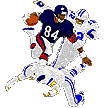 |
October 18, 2000
The GameThe power of a running back charging up the middle of the field. The quickness of a linebacker pouncing on a fumble.
The crushing tackle by a cornerback in the open field. These are some of the plays that make up the game of football and illustrate that football is a major contact sport. As a result of this contact, football is also a game of injuries. |
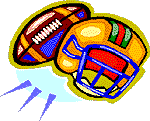 |
The ConcussionOne type of injury suffered by football players is a concussion. A concussion is defined as an impact to the head that causes a change in mental status. Changes in mental status include memory problems, dizziness, headaches, confusion, and blurred vision or even loss of consciousness. These symptoms may last a few minutes or many days. Not all people who have concussions lose consciousness. |
The Survey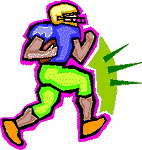 Although football players wear helmets and other protective equipment,
many players still suffer concussions. Studies published over the last 20
years indicate that 15-20% of high school football players
(200,000-250,000 players) suffer concussions each year. However, because
of recent rule changes and better safety equipment, a new study was
performed to determine if there were changes in the incidence of
concussions in high school and college football players. Researchers at
the Sports Medicine Research Laboratory at the University of North
Carolina analyzed data from 242 schools and 17,549 football players.
Although football players wear helmets and other protective equipment,
many players still suffer concussions. Studies published over the last 20
years indicate that 15-20% of high school football players
(200,000-250,000 players) suffer concussions each year. However, because
of recent rule changes and better safety equipment, a new study was
performed to determine if there were changes in the incidence of
concussions in high school and college football players. Researchers at
the Sports Medicine Research Laboratory at the University of North
Carolina analyzed data from 242 schools and 17,549 football players.
How often do football players suffer concussions? Researchers found that 888 players (5.1%) had
at least one concussion in a season. Researchers found that 888 players (5.1%) had
at least one concussion in a season.
What are the symptoms suffered by players with concussions?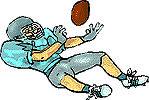
 The most common symptoms of players with
concussions were: headaches (86%), dizziness (67%), confusion (59%),
disorientation (48%), blurred bision (35.5%), amnesia (27.7%), loss of
consciousness (8.9%) The most common symptoms of players with
concussions were: headaches (86%), dizziness (67%), confusion (59%),
disorientation (48%), blurred bision (35.5%), amnesia (27.7%), loss of
consciousness (8.9%)
Which players suffer concussions? High school and college division III players
had a higher incidence of concussions than division II and division I
(larger schools) players. High school and college division III players
had a higher incidence of concussions than division II and division I
(larger schools) players.
When do players suffer concussions?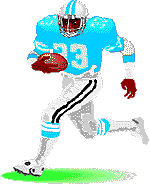
 Most (59.9%) of the concussions occurred
during games rather than during
practice. Most (59.9%) of the concussions occurred
during games rather than during
practice.
"Heads Up" on ConcussionsThis new report reveals that football players suffer fewer concussions compared with those of 20 years ago. The authors provide several possible explanations for this decreased incidence of head injury:
Even though concussions appear to have decreased in the number and severity over the last few years, the overall number of head injuries is still high. Moreover, players who have one concussion are approximately three times more likely to have a second concussion the same season than those players who have not had an injury. Several well-known professional football players (for example, Steve Young and Troy Aikman) have suffered multiple concussions during their careers. Head injuries jeopardize not only football players' careers, but their future health. Football is a game played by many people at multiple levels (e.g., Pop Warner, high school, college, professional). As with other contact sports, football carries the risk of injury. It is best that players, parents, coaches, trainers and physicians know these risks and that they work to avoid injury so a player can enjoy a long, healthy career off as well as on the girdiron. |
| Concussions
in the
National Football League (NFL) - through week 10 of the 2000
season Source: Seattle Post-Intelligencer, November 7, 2000, page C1 | |||
| Player | Position | Week/Date | Team |
| Troy Aikman | Quarterback | Week 1; 9/3/2000 | Cowboys |
| Akili Smith | Quarterback | Week 1; 9/3/2000 | Bengals |
| Frank Wycheck | Tight End | Week 4; 9/24/2000 | Titans |
| Antonio Freeman | Wide Receiver | Week 6; 10/8/2000 | Packers |
| Santana Dotson | Offensive Tackle | Week 6; 10/8/2000 | Packers |
| Cletidus Hunt | Defensive End | Week 6; 10/8/2000 | Packers |
| Brock Huard | Quarterback | Week 8; 10/22/2000 | Seahawks |
| Jon Kitna | Quarterback | Week 8; 10/22/2000 | Seahawks |
| Chris Chandler | Quarterback | Week 10; 11/5/2000 | Falcons |
| Charlie Batch | Quarterback | Week 10; 11/5/2000 | Lions |
Did you know? | In 1904, US President Theodore Roosevelt threatened to outlaw football after 19 college football players were killed or paralyzed from brain or spinal cord injuries. (Statistic from Maroon et al., Neurosurgery, 47:659-672, 2000.) |
| Grades of Concussion From Neurology, 48:581-585, 1997 |
| Grade 1 Symptoms: Transient confusion; inattention, poor concentration; no loss of consciousness; symptoms clear up in less than 15 minutes. Recommendations: remove from game; examine immediately and at 5 minute intervals; can return to play if symptoms clear up within 15 minutes. If player suffers a second concussion in the same game, the player should not return to play for a week after the symptoms clear up. |
| Grade 2 Symptoms: Same as Grade 1, but symptoms last longer than 15 minutes. Recommendations: remove from game and not allow the player back into the game that day; examine frequently; reexamine the following day by a trained person; return to play after one week without symptoms. If a player suffers a second Grade 2 concussion, the athlete should not return to play for at least two weeks without symptoms. A player should not return to play for an entire season if that player has an abnormal brain scan. |
| Grade 3 Symptoms: ANY (seconds or minutes) loss of consciousness Recommendations: get player to emergency room; perform immediate neurological examination and at daily intervals. After a brief (seconds) Grade 3 concussion, athletes should not return to play for one week after symptoms have cleared up; after a prolonged (minutes) Grade 3 concussion, athletes should not return to play for two weeks after symptoms have cleared up. If a player suffers a second Grade 3 concussion, the athlete should not return to play for at least one month without symptoms. |
|
|
They said it! | "Football
isn't a contact sport, it's a collision sport. Dancing is a
contact sport." --- Vince Lombardi, professional football coach (in Sports in America) by J. Michener |
| GO TO: | Neuroscience In The News | Explore the Nervous System | Table of Contents |
![[email]](./gif/menue.gif) Send E-mail |
 Fill out survey |
 Get Newsletter |
 Search Pages |